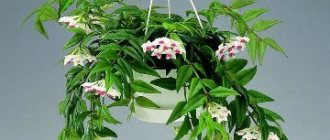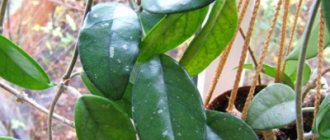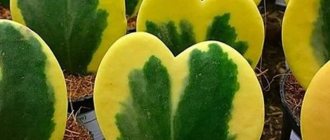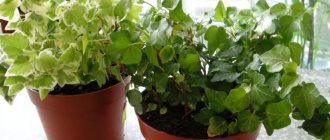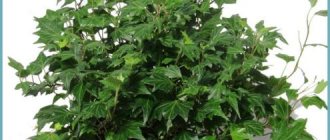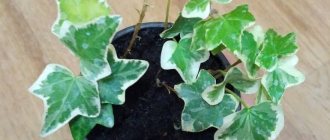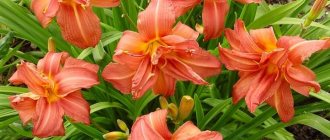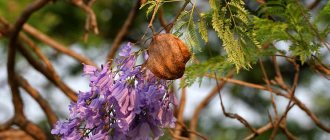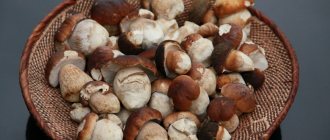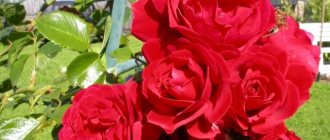Author: Natalya Category: Houseplants Published: January 20, 2019Republished: February 20, 2019Last edits: January 11, 2021
- Growing from seeds
- Insect pests
- Fleshy Hoya (Hoya carnosa), or waxy Hoya
plant (lat. Hoya) , or, as we call it, wax ivy , belongs to the genus of evergreen shrubs and vines of the subfamily Lastovnevye, family Kutrovye. More than two hundred species of hoya grow in the tropics of South and Southeast Asia, Polynesia and the west coast of Australia. Hoya liana prefers open forests, in which it finds a tree for support, or rocky slopes. The Hoya flower was named by the famous Scottish scientist Brown, the author of the theory of “Brownian movement”, in honor of his fellow English gardener Thomas Hoy, who devoted his life to growing tropical plants in the greenhouses of the Duke of Northumberland.
Planting and caring for hoya
- Flowering: in spring and summer, sometimes again in autumn.
- Lighting and watering: for species with succulent leaves - bright sunlight and moistening the substrate after the top layer of soil has dried; for varieties with light green pubescent foliage - bright sunlight and frequent watering; for species with thin leaves - bright, diffused light and frequent watering; for plants with dark green pubescent leaves - shade and frequent watering.
- Temperature: 17-25 ˚C in summer, 10-15 ˚C in winter.
- Air humidity: for species with succulent and pubescent leaves, this indicator is not important, but it is advisable to spray thin-leaved plants in extreme heat.
- Fertilizing: If you regularly change the substrate, fertilizing is not necessary, but if necessary, apply fertilizers for succulent plants.
- Rest period: not clearly expressed.
- Replanting: young plants - annually, adults - once every three years, if necessary.
- Reproduction: seeds and cuttings.
- Pests: aphids, scale insects, red spider mites, whiteflies and nematodes.
- Diseases: root rot, powdery mildew and gray mold.
- Properties: The aroma of hoya flowers can cause headaches.
Read more about growing hoya below.
How to transplant a Hoya into a new pot
The “plus” of growing the crop is that it does not require frequent replanting. It is carried out, if necessary, once every 1-3 years in the spring. Recommended substrate: flower soil mixture “For flowering succulents” or prepared independently according to one of the “recipes” discussed above.
Usually, the plant itself signals that replanting is necessary: the root system protrudes from the drainage into the holes at the bottom of the flowerpot, the bush or vine does not grow, and the leaves become drooping.
Before replanting your home hoya, you need to choose the right new pot. If the goal is to get abundant flowering, then the container should not be much larger than the one in which the crop grew before. If it is necessary to stimulate the growth of a bush or vine, then the pot should be much more spacious than the previous one. You must not forget to place drainage at the bottom (pebbles, broken shards, stones measuring from 1 to 1.5 cm, foam chips).
Transplanting a healthy crop into a new container and fresh substrate is carried out using the transfer method - that is, an earthen ball entwined with roots is not destroyed, but is transferred to another container and supplemented with the required amount of soil. When planting, the hoya is not deeply buried; the transplanted plant requires standard care - as described above.
Botanical description
In nature, an adult plant can reach 10 meters in length. Leafless young shoots have a violet-brown tint, but as they grow older, when leaves and aerial roots begin to appear on them, the shoots turn green and become woody over time. Fleshy and shiny at a young age, the leaves gradually become dull; they are oval in shape and pointed towards the top. The leaf size is 5-8 cm in length and 3-5 cm in width. Hoya flowers, white or pinkish, bisexual, star-shaped, are collected in umbrellas located on stem branches. The diameter of each flower is 1-2 cm, except for the flowers of Hoya imperialis, which reach 8 cm in diameter. In the center of the corolla of the flower there is a five-membered crown, rising above the petals. The flowers are fragrant and produce nectar that attracts insects.
In culture, hoya can bloom only in brightly lit windows; in addition, the plant has become so domesticated that it no longer needs to be in the fresh air even in the warm season. Indoor hoya is divided into three categories:
- ampelous hoya, or hanging;
- hoya ivy wrapping around the support;
- erect hoya forming a bush.
Diseases and possible problems
Too high humidity and cold can cause the development of powdery mildew and gray rot in hoya. In this case, whitish or gray spots form on the leaf blades. In order to cure powdery mildew, you need to use fungicidal preparations. If the vine is affected by gray rot, it can die in just a few days.
Thickenings and spots that appear on the leaf plates may be a sign that the flower is affected by a viral infection. In this case, Hoya needs to be isolated from other flowers and observed for some time. If the situation worsens, the diseased specimen must be burned, because viral diseases are considered incurable.
If some of the stems and trunk have become soft and a sticky liquid with a not very pleasant aroma is released from them, this may mean that the Hoya is affected by a bacterial infection. In this case, the flower is sprayed with a product containing copper. All diseased parts of the bush need to be pruned.
Such a plant can also be affected by a non-infectious disease, as a rule, this is due to a violation of the rules of flower care or unsuitable conditions. Below we will talk in detail about the problems that most often arise with such a vine.
- Spots on foliage. They can form because the hoya is watered with cold water, or from excess sunlight, or from overfeeding the plant with mineral fertilizers.
- The foliage is drying. The leaf blades become faded, curl and dry out, either from excessively intense light, or from too cold water used for irrigation, or if the room is very cold.
- Slow growth. The foliage becomes faded and growth slows down due to the fact that the substrate contains insufficient nitrogen. In this case, the bush will need fertilizing with a urea solution (10 g per 1 bucket of water).
- Flying leaves. Leaf flying may be due to the fact that there is not enough water in the substrate or, on the contrary, there is too much of it; it may also be due to the fact that the room is very hot, dry, and watering is excessively poor.
- The foliage turns red. Reddening of the leaves may be due to excessively intense lighting or because the room is very hot.
- Flying around flowers and buds. The falling of flowers and buds may be due to the fact that the bush was moved to another place during flowering, or due to a lack of light, or due to regular stagnation of water in the substrate.
- Root rotting. Stagnation of water in the substrate, associated with poor drainage and overflow, can cause rot on the root system. This can lead to the death of the flower.
- Sparse flowering. As a rule, hoya blooms poorly due to lack of light. If the plant does not see sunlight, then it will not bloom at all. There are also species in which young bushes begin to bloom only 2–4 years after planting. In some cases, this is due to the fact that the bush has not had enough rest in the winter. Cool conditions in winter, scanty watering, and 2–3 months without fertilizing can provoke lush flowering after the pot is returned to a warm place in the spring.
- Yellowing and falling of the lower leaf blades. The development of young stems deteriorates, and the lower foliage becomes yellow and flies off due to hypothermia of the substrate or bush.
Pests
The greatest harm to hoya can be caused by root nematodes. The affected bush experiences stunted growth, cessation of development, and areas of first yellow and then brown color appear on the roots, then they die. To get rid of such a harmful insect, the bush is treated with an insecticidal preparation: Lindane, Phosfamide or Mercaptophos. The root system should be washed in slightly hot water (50 to 55 degrees). Excessively affected roots must be removed. The bush will need to be transplanted into a new container with fertile substrate.
Less commonly, spider mites, aphids, mealybugs and other sucking pests settle on such a vine. The affected bush becomes faded, the foliage turns yellow and flies off, growth becomes slower, the buds do not open, and the flowers become sticky due to pest secretions. For prevention purposes, it is necessary to systematically inspect the bush for the presence of “uninvited guests”
It is especially important to do this at the beginning of spring, when young stems begin to grow. If there are very few insects, then it will be enough to wash the bush under a warm shower
All parts must be washed. When the foliage dries, the plant is treated with an insecticidal agent (Fitoverm, Karbofos or Actellik). Hoya must be sprayed strictly following the instructions. Repeated treatment can be carried out after 7 days.
Caring for Hoya at home
Growing conditions
Different types of hoya are grown in culture, and each requires fulfillment of its own conditions of maintenance, so it is difficult to give general recommendations for all types. The only wish common to all plants of the Hoya genus is to avoid overmoistening the soil, as a result of which liquid mud forms in the roots.
- Krinum: cultivation and care, types and varieties
For convenience, we divide hoyas into categories according to the amount of moisture consumed and the required level of lighting:
- Indoor Hoya flower with hard succulent leaves (Hoya fleshy, Hoya Kerry). The optimal location is on a south window, under the rays of the sun. Watering is carried out after the top layer of the substrate has dried. An exception is southern hoya (Hoya australis), which needs constantly moist (but not wet!) soil.
- Types and varieties of hoya with thin leaves (Hoya multiflorum) require constant moisture in the earthen ball and shading from direct sunlight; the ideal place for them is an eastern or western window, and they will do well on a northern window.
- The Hoya houseplant with light green, hairy leaves (Hoya lineara) grows best in full sun and requires regular watering without drying out the clump.
- Hoyas with dark green pubescent leaves (Hoya Thompson, Hoya serpentine) love shady coolness and regular watering without drying out the earthen ball.
As for the comfortable temperature for Hoya, in summer it is 17-25 ºC, and in winter - not lower than 10 ºC, although it would be better a little higher - about 15 ºC. The exception is the beautiful hoya (Hoya bella), which loses its leaves from the cold.
At home, Hoya does not have a pronounced dormant period, but if you notice that the plant has slowed down, reduce watering and stop feeding - let the Hoya rest. Hoya usually stops growing when the daylight hours become short, but if you decide on additional lighting for the plant, the hoya may skip the dormant period.
Fertilizer
In nature, different types of hoya grow in different places, in different soils, and therefore need different types of fertilizers. But according to many observations, the results of which have been published, it is best to feed hoyas with fertilizers for flowering succulents - all species respond well to them. And if you regularly replant the hoya into fresh substrate, then you don’t have to resort to fertilizing at all.
Transfer
Young plants are replanted annually in the spring, and adults - once every three years, if necessary. Hoya does not need a large pot, but buy a new pot for replanting every time - the one left over from some other plant is not suitable. And even a new pot, before transplanting the hoya into it, must be thoroughly washed with ordinary soap, and the substrate must be sterilized.
The soil for hoya needs to be breathable, neutral or slightly acidic, preferably of the following composition: one part of humus and leaf soil and two parts of clay-turf, but many grow hoya in an orchid substrate and even just in garden soil - it all depends on the type of hoya, so approach plant replanting creatively, having first studied the conditions and soil in which your Hoya grows in the wild. A layer of drainage is placed at the bottom of the pot, and the plant is transferred to a new pot along with a lump of earth.
Hoya flower: care, replanting
It's no secret that plants feel much better in larger pots. Experts recommend replanting young hoya specimens at least once a year, and adults - every three. The plant grows well in neutral or slightly acidic soil, where the pH does not exceed 6.5. Although this ivy is unpretentious, it also requires a special mixture consisting of two parts clay-turf and one measure each of leaf soil, peat and sand.
In turn, Hoya the Beautiful prefers a different mixture. It is made from equal parts of leaf soil, peat, humus and sand with a small addition of charcoal. Almost all plants require good drainage. Hoya (flower) is no exception.
Hoya propagation
Growing from seeds
How to propagate hoya if you happen to be the owner of a rare treasure - hoya seeds? Ripe and well-dried hoya seeds in the year of their collection are sown in a loose substrate consisting of an earthen mixture and chopped sphagnum moss. The seeds germinate within a week, and as soon as the shoots appear, you must ensure that the soil in the crops never dries out and at the same time is not wet. Keep the bowl with seedlings in a warm, bright place.
- Aloe - healing properties
To prevent fungal diseases, spray the seedlings with Bordeaux mixture or any other copper-containing preparation in strict accordance with the instructions. After 90 days, when the seedlings produce several pairs of leaves, they are planted in personal pots. However, growing hoya from seeds is made difficult by the fact that seed material cannot be found on sale, and it is almost impossible to obtain seeds from hoya growing at home.
Propagation by cuttings
This is the easiest and most reliable way to get a new plant, since Hoya cuttings take root easily. The stalk should be short, but have at least two nodes and one or two pairs of leaves. You can root cuttings in water or in a substrate. To root in water, wrap the container with foil on all sides, making holes for the cuttings. Leave only the top pair of leaves on the cuttings, treat the lower sections with rooting hormone and push the cuttings through the holes in the foil to such a depth that the lower node is in the water.
The temperature for rooting should not be higher than 22 ºC, but high air humidity is also important for this process, otherwise the cuttings will simply wither. To increase air humidity, place a transparent plastic bag over the container with cuttings, but do not block the air access underneath it. Hoya rooting occurs after two weeks, and it is important to transplant the cuttings to a permanent place at an early stage of root formation, otherwise the cuttings become fragile and break.
How can you root Hoya directly in the substrate? The soil for rooting must have such permeability that excess water can easily flow through it. Before planting, treat the lower cut of the cuttings with root. Sterilize the substrate and pot, place the cutting in the soil to such a depth that the bottom node is in the soil. If the air humidity in the room is low, place a transparent bag loosely over the pot with cuttings. After 2-3 weeks, signs of new growth should appear. If you received cuttings for rooting in the mail and it seems to you that they are too dry, soak them for several hours in slightly sweet water and they will restore their moisture.
How to care for a plant during the breeding season
In order for flowers to appear on a young plant in the year of transplantation, it is necessary to propagate it with stem layering. To do this, an incision is made on the shoot and covered with moss, and then wrapped in plastic wrap and tied. Soon roots will appear on it, after which its top is cut off and buried in the ground. In order to get a dense bush, three, four, or even five shoots are planted in one pot at once.
As you know, many house plants can be propagated by cuttings. These include hoya (flower). Even a novice amateur knows how to care for her during this period. This plant is propagated throughout the growing season, and the cuttings can be of varying lengths. However, it is best to have one or two pairs of leaves.
The cuttings are always cut below the nodes, since roots can grow not only from them, but also between them. They are rooted either in water or in a substrate consisting of peat and sand in a ratio of 2 to 1. At this time, it is necessary to monitor the soil temperature so that it remains at 20⁰C. Typically, cuttings take root after three weeks, after which they are planted in a mixture of one part turf and two parts leaf soil and sand with a small addition of humus in pots with a diameter of no more than 10 cm.
Hoya pests and diseases
Insect pests
Hoyas are very resistant to all troubles, but if they grow in unsuitable conditions and are poorly cared for, then the plants may have problems with scale insects, aphids and red spider mites, the fight against which consists of treating the hoya with actellik or some other insecticide, but species and varieties with thick leathery leaves can be saved from pests by wiping the leaves with a swab dipped in alcohol. And so that the hoya is not pestered by nematodes, the soil and pot must be sterilized when replanting the plant.
Why doesn't hoya bloom?
Usually the reasons why hoya refuses to bloom are overwintering in a too warm room, excessive fertilization, too much pruning or insufficient lighting.
How to make hoya bloom
What to do if hoya does not bloom? Correct mistakes in care: let the plant rest in the winter in a cool room - on an insulated, unheated loggia or balcony, reducing watering and stopping fertilizing, and in the spring bring the hoya into a warm place under bright, diffused light, resume watering and fertilizing. Also make sure that the hoya pot is not too large - for an adult plant, 15-20 cm in diameter is enough.
- Guzmania flower
Hoya turns yellow
If your plant suffers from too much heat or insufficient light, its leaves will turn yellow. Decide for yourself how to deal with this by once again studying the rules for keeping hoya at home.
How to control pests
Even a houseplant can become infected with parasites, which in most cases are found on the stems and leaf blades of the plant. If a spider mite or aphid is detected, it is necessary to immediately move the pot with the vine to the quarantine zone so that other crops are not damaged. After this, it is necessary to assess the degree of danger and understand whether it is worth using an insecticidal drug or whether some folk remedy will suffice.
If there are not too many parasites on the flower, then in most cases a soap solution with a small amount of garlic will help to deal with them. The product is applied using a sponge (you will need to treat each leaf and vine). However, controlling large numbers of pests this way can be quite difficult. Therefore, do not forget about the possibility of using insecticidal preparations (treatment is carried out strictly according to the instructions).
The best prevention against pests is regular warm showers. But how exactly are indoor plants affected by insects? In most cases, this occurs after purchasing a new plant that was not properly checked for pests before placing it in the home. Even in small numbers, spider mites or aphids can multiply in a matter of days. Therefore, carefully inspect any crops after you have purchased them.
Is it possible to keep Hoya at home?
Most often, Hoya is grown not in apartments, but in offices and studies, and the reason for this is superstition. For a long time, people believed that wax ivy survives the husband’s family and drives adult sons out of the house. Other, no less convincing sources claim that hoya relieves feelings of resentment and pacifies envy. There are publications that say that hoya is “a plant of family happiness, it is advisable to place it in the bedroom.” What to believe? Maybe it’s worth trying to grow hoya at home and clarify the degree of its influence on a person’s destiny? You decide. I see in hoya only a cozy plant with beautiful flowers, caring for which is a pleasure.
General information
In the wild, the hoya flower grows in tropical Australia, the Malay Archipelago, southern China and some areas of India. Its vines can creep along rocky slopes and tree trunks. This is an evergreen plant with climbing and creeping shoots. Its leaves are ovate, oval or heart-shaped and have fleshy, leathery axillary inflorescences. The flowers are shaped like an umbrella and have five rounded petals, collected in inflorescences.
In general, hoya, the secrets of caring for which are described below, is a rather unusual and beautiful ornamental plant. It can feel great both in warm and moderate, and in fairly cool rooms. The main thing for her is to have reliable support.
Types and varieties
Not so long ago, only Hoya carnosa, or Hoya fleshy, and Hoya bella, also known as Hoya beautiful, represented the indoor plant Hoya in cultivation.
Fleshy Hoya (Hoya carnosa), or waxy Hoya
An evergreen climbing plant, reaching a length of 6 meters and requiring support. Fragrant flowers, white with a pink crown in the center, are collected in a rosette. It has small oval leaves, thick and tough, covered with a waxy coating and silvery markings on a dark green background.
Although there are varieties of this species:
- Hoya variegated (for example, the Crimson Queen variety with a cream border along the edge of the green leaf);
- Hoya tricolor - the “Exotic” variety with scarlet flowers, and the leaves, in addition to green, are colored in cream and pink shades;
- Hoya compacta is a variety with small leaves and barely noticeable patterns on them.
Hoya bella
A branching shrub with small, ovate-lanceolate, densely growing leaves on hanging shoots. The flowers of this species are so perfect that they seem like jewelry - small white stars with a purple crown, collected in umbrellas of 7-9 pieces. The leaves, depending on the variety, can be solid green or variegated. Hoya beautiful is often grown as an hanging plant.
In addition to these two well-established species in culture, today they are becoming increasingly widespread:
Hoya multiflora, or multi-flowered
A climbing plant with oblong-linear leaves and numerous yellow flowers with narrow petals and a crown with arched spurs;
Hoya majestic (Hoya imperialis)
In nature, it is a shrub with oval-oblong leathery leaves 15-20 cm long on pubescent cuttings 5-7 cm long. The shoots are also pubescent. Fragrant flowers, collected in umbels of 6-10 pieces, with a short pubescent crown, dark red on the inside and yellow-green on the outside;
Hoya lacunosa, or concave (Hoya lacunosa)
In nature, it is an epiphyte; in culture, the shoots look like densely growing cascades of lashes, covered with dark green diamond-shaped leaves up to 6 cm long with curled edges, which is why the leaf plate appears concave. Young shoots have a red-brown tint. The flowers collected in umbels have a white fleecy corolla with a yellow center;
Hoya Kerry (Hoya kerrii)
It has leaves shaped like a heart, which is why it is called “Valentine” or “hoya in love.” The stems have to be tied up to prevent them from falling. The leaves are succulent, length and width from 5 to 15 cm. The pubescent flowers are collected in 15-25 pieces in spherical umbrellas, their color depends on the amount of light in the room where the hoya grows: white with a barely noticeable lemon tint, yellowish, yellow-lemon or soft pink. Move the flower further away from the window or, conversely, closer to it, and the shade of the flowers will change. Moreover, as it ages, due to the dark-colored nectar, the flower’s petals become pink, then dark pink, then red-brown.
Hoya serpentine (Hoya serpens), fragrant hoya (Hoya odorata), cupped hoya (Hoya calycina), Hoya mindorensis (Hoya mindorensis), southern hoya (Hoya australis) and others are also known in culture.
Problems in growing
Hoya feels great at home, rarely causing concern. All problems are usually related to violation of containment conditions.
photo by the author
If your hoya leaves turn yellow...
This is usually a reaction to a change in temperature; the plant is probably cold, or has been watered with cold water. The cause could also be waterlogging or stagnation of water at the roots! The soil should not become sour, and the temperature should be constant and stably warm.
If the hoya doesn't bloom...
Like any flowering plant, hoya needs light, nutrition and stable watering to form flower stalks. Provide good lighting and fertilizing, check if the roots are cramped in the pot, or if it is too big for the plant.
If your hoya has plaque on its leaves...
The flower can be affected by fungal and bacterial diseases, which is facilitated by dry air and improper watering. Do not allow the soil to become acidic, also give the plant a regular shower, this is an excellent prevention of fungal diseases! In addition, it is useful to periodically spray the leaves with natural preparations; they can be made at home (folk recipes for flowers).
Already existing plaque can be wiped off with a soft sponge during “shower procedures” using mild soap and, if necessary, treated with fungicides (for example, Bordeaux mixture).
If your hoya drops its leaves...
Leaves may turn yellow and fall off if overwatered. This often happens due to a disproportionately large pot, or a mismatch in temperature conditions and watering. Don't forget: the lower the temperature, the less watering!
If your hoya's buds fall off...
Although the wax vine has an accommodating disposition, during the flowering period it becomes quite capricious. Hoya is especially sensitive to changes in location. Any movement relative to sunlight can result in buds falling off. At the same time, the brushes that have already formed and are ready for flowering will remain intact, but only the beginnings of future flowers that have appeared may dry out and fall off. Stability is important in everything! Therefore, during budding, it is necessary to monitor the condition of the soil: avoid drying out and overflowing.
Brown spots on hoya leaves...
Wax ivy is sometimes affected by pests - scale insects, thrips. When pests are detected, only insecticides (for example, the drug "Aktara") can help; a warm shower and spraying are useful as preventive measures.
Sometimes brown spots are a consequence of sunburn after exposure to direct rays, or the result of mechanical trauma.
- Online pest diagnostics.
- Online diagnosis of diseases.
This plant will appeal to all lovers of indoor vines! In addition, now you know that hoya at home can bloom regularly.
Hoya in different seasons
This plant blooms even in winter. If you want to create such beauty for yourself, then you need to prepare the flower for this in September. To do this, place the container with the plant on the east side.
At the beginning of winter, the flower is watered very little, and as a result, flowers appear on the plant. The most ideal temperature for this period of time is 15 degrees Celsius.
There are also types of hoya that do not like coolness; these include multiflora. If the temperature is below 20 degrees, then it loses leaves and flowers.
As a rule, winter is an opportunity for Hoya to rest, and at this time it is better to water and fertilize it less. It blooms in the warmest times of the year, just when it needs constant care. And all this time the flower needs light.
